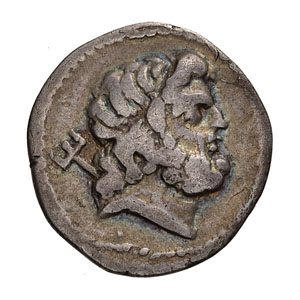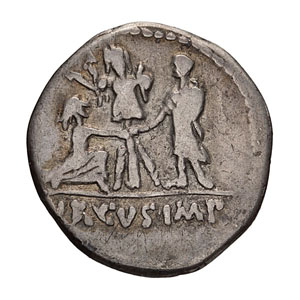|
|
 |
 |
 |
 |
 |
 Lot
# 440 - Auction is closed. Lot
# 440 - Auction is closed. Estimate: US$4000
/ Price Realized: US$4000 Estimate: US$4000
/ Price Realized: US$4000
|
 |
 L. Staius Murcus. Denarius L. Staius Murcus. Denarius
|
 |
|
 |

|
 
|
L. Staius Murcus. Denarius, 3.73gg. (12h). , 42-41 BC. Obv: Head of Neptune ight., with trident over shoulder. Rx: Male figure on right, with right hand raising kneeling female figure on left; behind, trophy; in exergue, [MV]RCVS IMP. Crawford 510/1. Sydenham 1315 (R8). RSC Statia 1. Sear, Imperators 337. Bold Fine.
Lucius Staius Murcus began his political career as a legate of Caesar in Gaul and Africa from 48-46 BC. After Caesar's murder, he was appointed proconsul of Syria by the Senate. When Cassius arrived in the province in 43 BC, Murcus promptly transferred his allegiance and legions to the Liberator and was rewarded with command of a fleet. He demonstrated considerable skill as a naval tactician and in uneasy partnership with Ahenobarbus achieved complete control of the Adriatic and the seas around Greece. After the Republican disaster at Philippi, the two admirals waited developments in the Ionian Sea in support of no cause but their own, pirates in all but name. Murcus eventually made the ill-fated decision to throw in his lot with Sextus Pompey in Sicily. Pompey no doubt welcomed the arrival of Murcus' ships and well-seasoned crews, but Murcus himself was inconveniently accustomed to his own independent command. The two men soon quarreled; Pompey accused Murcus of conspiracy and ordered his execution in 40/39 BC.
The rare coinage of Staius Murcus has never received the careful examination it merits. The depiction of Neptune on the obverse is an exact echo of an issue struck by Brutus in the previous year (Crawford 507/2), perhaps an indication of Murcus' lingering allegiance to the Republican cause. The type and legend of the reverse is more difficult to explain. For what victory did Murcus justify the adoption of the title IMP for Imperator? Sear in "Imperators" suggests the successful siege of Bassus in Apamaea in 43 BC as a suitable occasion, but Republican commanders didn't typically claim the title imperator for victory over their fellow Romans. Nor would that land siege two years earlier resonate with the sailors under Murcus' command in 41 BC, presumably the intended targets of the message. How does the title relate to the scene depicted? Is the standing male figure Murcus? Is the kneeling figure Roma, as suggested by Crawford? Again, what battle is represented by the trophy?
An attractive example of an extremely rare coin, without the porosity, poor centering and double-striking that notoriously plague this issue. It's been plausibly suggested that the endemic double-striking indicates that these coins were actually struck aboard a ship in Murcus' fleet!.
|
|

